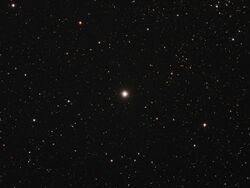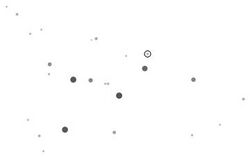Astronomy:Chi Cassiopeiae
| Observation data Equinox J2000.0]] (ICRS) | |
|---|---|
| Constellation | Cassiopeia |
| Right ascension | 01h 25m 56.02238s[1] |
| Declination | +68° 07′ 48.0460″[1] |
| Apparent magnitude (V) | +4.696[2] |
| Characteristics | |
| Spectral type | G9 IIIb[3] |
| U−B color index | +0.762[2] |
| B−V color index | +0.997[2] |
| Astrometry | |
| Radial velocity (Rv) | +6.66±0.14[4] km/s |
| Proper motion (μ) | RA: −43.03±0.34[1] mas/yr Dec.: −22.31±0.32[1] mas/yr |
| Parallax (π) | 15.67 ± 0.39[1] mas |
| Distance | 208 ± 5 ly (64 ± 2 pc) |
| Absolute magnitude (MV) | +0.52[5] |
| Details[5] | |
| Mass | 2.04 M☉ |
| Radius | 11.0±0.8[3] R☉ |
| Luminosity | 67.6 L☉ |
| Surface gravity (log g) | 2.21 cgs |
| Temperature | 4,746 K |
| Metallicity [Fe/H] | −0.34 dex |
| Rotational velocity (v sin i) | 0.44±0.45[6] km/s |
| Age | 1.0 Gyr |
| Other designations | |
| Database references | |
| SIMBAD | data |

Chi Cassiopeiae (χ Cassiopeiae) is a solitary,[8] yellow-hued star in the constellation Cassiopeia. It is visible to the naked eye with an apparent visual magnitude of +4.7.[2] Based upon an annual parallax shift of 15.67 mas as seen from Earth,[1] this system is located roughly 208 light years from the Sun. At that distance, the visual magnitude is diminished by an extinction of 0.18 due to interstellar dust.[4]
With a stellar classification of G9 IIIb,[3] it has the spectrum of an evolved, G-type giant star. It has an estimated age of a billion years[5] and is a red clump star that it is generating energy through helium fusion at its core.[9] The star has about double[5] the mass of the Sun and has expanded to 11[3] times the Sun's radius. It is radiating 67.6 times the Sun's luminosity from its photosphere at an effective temperature of 4,746 K.[5]
References
- ↑ 1.0 1.1 1.2 1.3 1.4 1.5 van Leeuwen, F. (2007), "Validation of the new Hipparcos reduction", Astronomy and Astrophysics 474 (2): 653–664, doi:10.1051/0004-6361:20078357, Bibcode: 2007A&A...474..653V.
- ↑ 2.0 2.1 2.2 2.3 Jennens, P. A.; Helfer, H. L. (September 1975), "A new photometric metal abundance and luminosity calibration for field G and K giants", Monthly Notices of the Royal Astronomical Society 172 (3): 667–679, doi:10.1093/mnras/172.3.667, Bibcode: 1975MNRAS.172..667J.
- ↑ 3.0 3.1 3.2 3.3 Nordgren, Tyler E. et al. (December 1999), "Stellar Angular Diameters of Late-Type Giants and Supergiants Measured with the Navy Prototype Optical Interferometer", The Astronomical Journal 118 (6): 3032–3038, doi:10.1086/301114, Bibcode: 1999AJ....118.3032N, http://digitalcommons.wcupa.edu/cgi/viewcontent.cgi?article=1008&context=phys_facpub.
- ↑ 4.0 4.1 Famaey, B. et al. (January 2005), "Local kinematics of K and M giants from CORAVEL/Hipparcos/Tycho-2 data. Revisiting the concept of superclusters", Astronomy and Astrophysics 430: 165–186, doi:10.1051/0004-6361:20041272, Bibcode: 2005A&A...430..165F.
- ↑ 5.0 5.1 5.2 5.3 5.4 Takeda, Yoichi et al. (August 2008), "Stellar Parameters and Elemental Abundances of Late-G Giants", Publications of the Astronomical Society of Japan 60 (4): 781–802, doi:10.1093/pasj/60.4.781, Bibcode: 2008PASJ...60..781T.
- ↑ Jofré, E. et al. (2015), "Stellar parameters and chemical abundances of 223 evolved stars with and without planets", Astronomy & Astrophysics 574: A50, doi:10.1051/0004-6361/201424474, Bibcode: 2015A&A...574A..50J.
- ↑ "chi Cas". SIMBAD. Centre de données astronomiques de Strasbourg. http://simbad.u-strasbg.fr/simbad/sim-basic?Ident=chi+Cas.
- ↑ Eggleton, P. P.; Tokovinin, A. A. (September 2008), "A catalogue of multiplicity among bright stellar systems", Monthly Notices of the Royal Astronomical Society 389 (2): 869–879, doi:10.1111/j.1365-2966.2008.13596.x, Bibcode: 2008MNRAS.389..869E.
- ↑ Valentini, M.; Munari, U. (November 2010), "A spectroscopic survey of faint, high-Galactic-latitude red clump stars. I. The high resolution sample", Astronomy and Astrophysics 522: A79, doi:10.1051/0004-6361/201014870, Bibcode: 2010A&A...522A..79V.
 |


